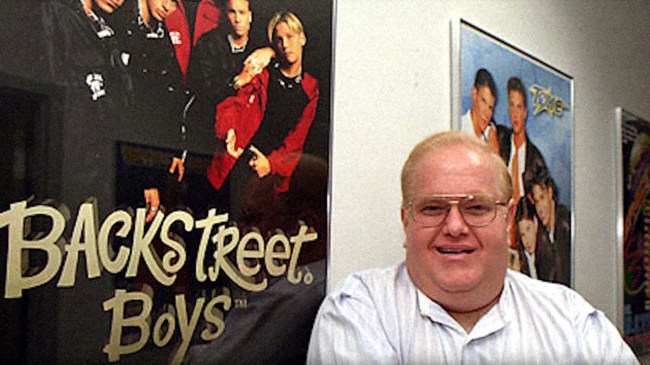
If you’ve ever belted out “I Want It That Way” or “Bye Bye Bye,” you’re familiar with the music that made Lou Pearlman‘s net worth reach its height. But the real story behind the man who launched these iconic boy bands is a rollercoaster ride of fame, fortune, and fraud that’ll make your jaw drop.
Born in New York City on June 19, 1954, Lou Pearlman grew up as a regular kid in Queens, dreaming big but starting small. His journey from humble beginnings to pop music mogul was as unexpected as it was impressive. He struck gold when he formed and managed the Backstreet Boys in 1993, followed closely by NSYNC in 1995. These groups became the soundtrack of a generation—dominating charts, selling out arenas, and turning Pearlman into a music industry titan.
But Pearlman’s story isn’t just about chart-topping hits and screaming fans. It’s a cautionary tale of greed, deception, and a wild fall from grace. From reaching multimillionaire status to eventually facing bankruptcy and prison time, Pearlman’s financial journey is just as dramatic than any boy band ballad. Up ahead, we’re taking a deep dive into Lou Pearlman’s net worth, exploring how he built his empire and the shocking lows that followed.
What was Lou Pearlman’s net worth at its peak?
At the height of his success in the late ’90s and early 2000s, Celebrity Net Worth estimates that Pearlman’s net worth peaked at approximately $200 million. But how did he get there?
As a kid growing up in the Big Apple during the 1960s, Pearlman wasn’t exactly dreaming of gold records and multimillion-dollar record deals. Instead, his head was in the clouds—literally. He loved aviation, a passion that would shape his early career path. Pearlman’s first business venture didn’t exactly take off, however. His first blimp advertising company, Airships International, experienced a setback when its only airship crashed after leaving the ground.
But Pearlman wasn’t one to let his dreams deflate so easily. He pivoted and established Trans Continental Airlines, an air charter service that would eventually ferry musical acts and affluent clients around the globe. Inspired by this brush with the music industry, he placed an advertisement in the Orlando Sentinel looking to form his own vocal group.

This seemingly simple classified ad would lead to the formation of the Backstreet Boys in 1993, a group that would go on to become the best-selling boy band in history, with over 100 million records sold worldwide. Sensing a winning formula, Pearlman replicated this success with NSYNC in 1995. These two groups would become the jewels in Pearlman’s crown, achieving tons of success and turning the music mogul into a millionaire many times over.
But Pearlman didn’t stop there. He went on to create and manage other groups like O-Town, LFO, Take 5, and the girl group Innosense (which briefly included a young Britney Spears). While these acts didn’t reach the stratospheric heights of the Backstreet Boys or NSYNC, they contributed to Pearlman’s growing empire.
Pearlman’s wealth allowed him to live a lavish lifestyle, complete with a 16,000-square-foot mansion in Orlando, private jets, and a yacht. He was the toast of the music industry, rubbing elbows with celebrities and enjoying the fruits of his labor (and fraud—more on that ahead).
What was Lou Pearlman’s net worth at the time of his death?
At the time of his death in 2016, Celebrity Net Worth estimated Lou Pearlman’s net worth at a staggering negative $400 million. Yes, you read that right—negative.
How did the man who once had it all end up so deep in the red? The answer lies in a massive Ponzi scheme that would eventually leave him bankrupt and in prison. For over 20 years, Pearlman had been running a fraudulent investment operation, convincing people and financial institutions to pour over $1 billion into nonexistent companies. After creating the Backstreet Boys and NSYNC, he leveraged their fame to lure even more unsuspecting investors into his web of lies. Pearlman’s arsenal included falsified documents to win investor confidence and fake financial statements to secure bank loans.

Investigators discovered the Ponzi scheme—which turned out to be the longest-running in U.S. history—in 2006. The jig was up for Pearlman in early 2007 when Florida authorities seized his fraudulent Trans Continental Savings Program, a subsidiary of his Trans Continental International Inc. company (which also had his record company, Trans Continental Records, under its umbrella). Pearlman fled the country, but his days as a fugitive were numbered. Later that year, he was arrested in Indonesia and brought back to face the music.
In 2008, Pearlman pleaded guilty to a litany of charges, including conspiracy, money laundering, and making false statements during bankruptcy proceedings. He was slapped with a 25-year prison sentence, effectively ending his career and leaving him with a mountain of debt he’d never climb. Pearlman and his companies were forced into involuntary bankruptcy, with his assets and belongings auctioned off to the highest bidders.
How much did Lou Pearlman make from NSYNC and the Backstreet Boys?

The exact figures of Pearlman’s earnings from NSYNC and the Backstreet Boys are as murky as some of his business dealings. However, it’s safe to say he made a pretty penny off these chart-topping groups.
Pearlman’s contracts with the bands were notoriously exploitative. He often took a larger cut of their earnings than the artists themselves, sometimes as much as 50% of their net profits. Considering that both NSYNC and the Backstreet Boys were multi-platinum selling artists with sold-out tours and merchandise flying off the shelves, Pearlman’s take was substantial.
The bands eventually sued Pearlman for misrepresentation and fraud. NSYNC settled out of court in 1999, while the Backstreet Boys’ legal battle dragged on until 2014, long after Pearlman’s downfall. While we don’t have exact numbers, it’s estimated that Pearlman pocketed tens of millions from these groups alone.







